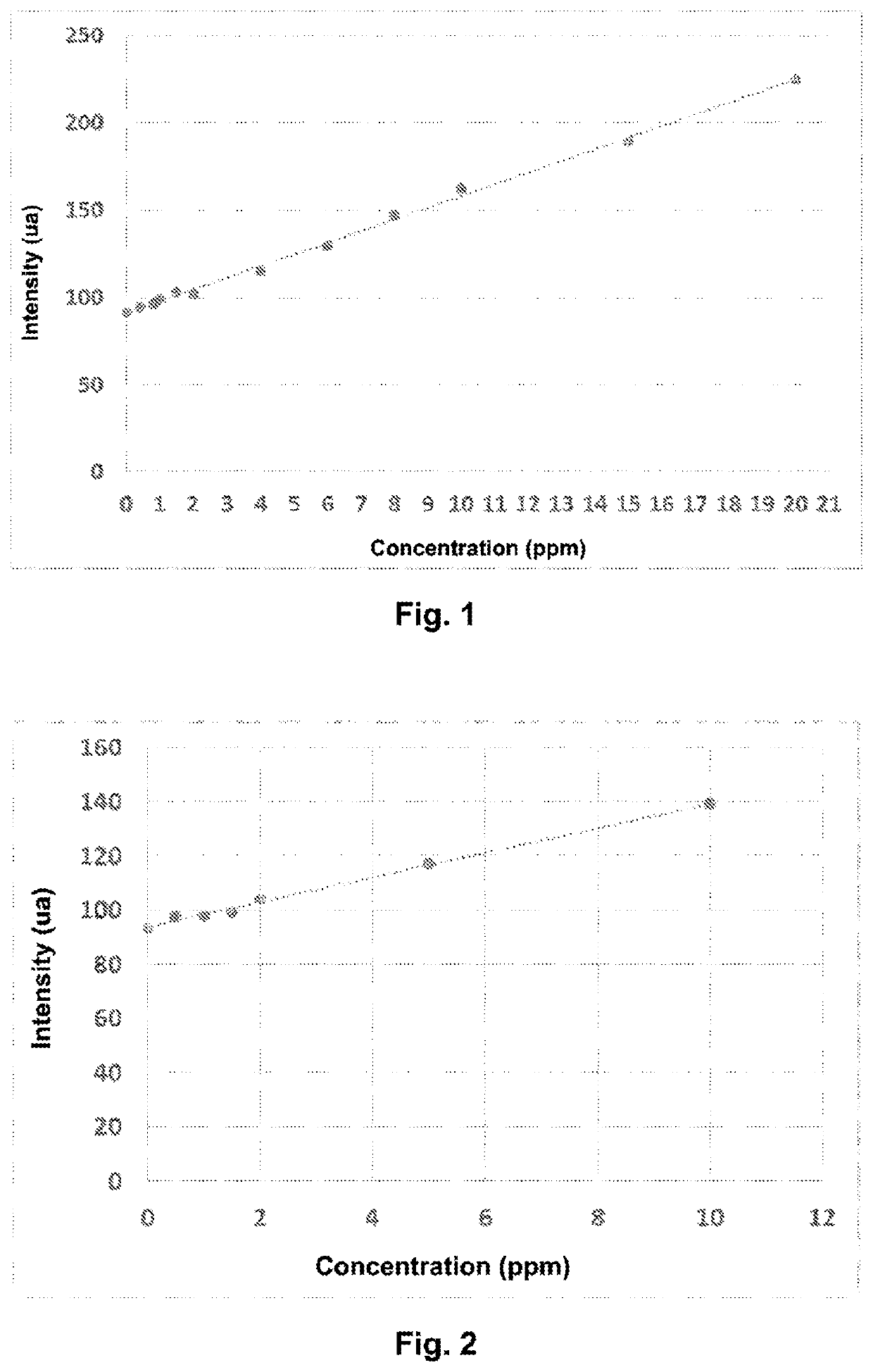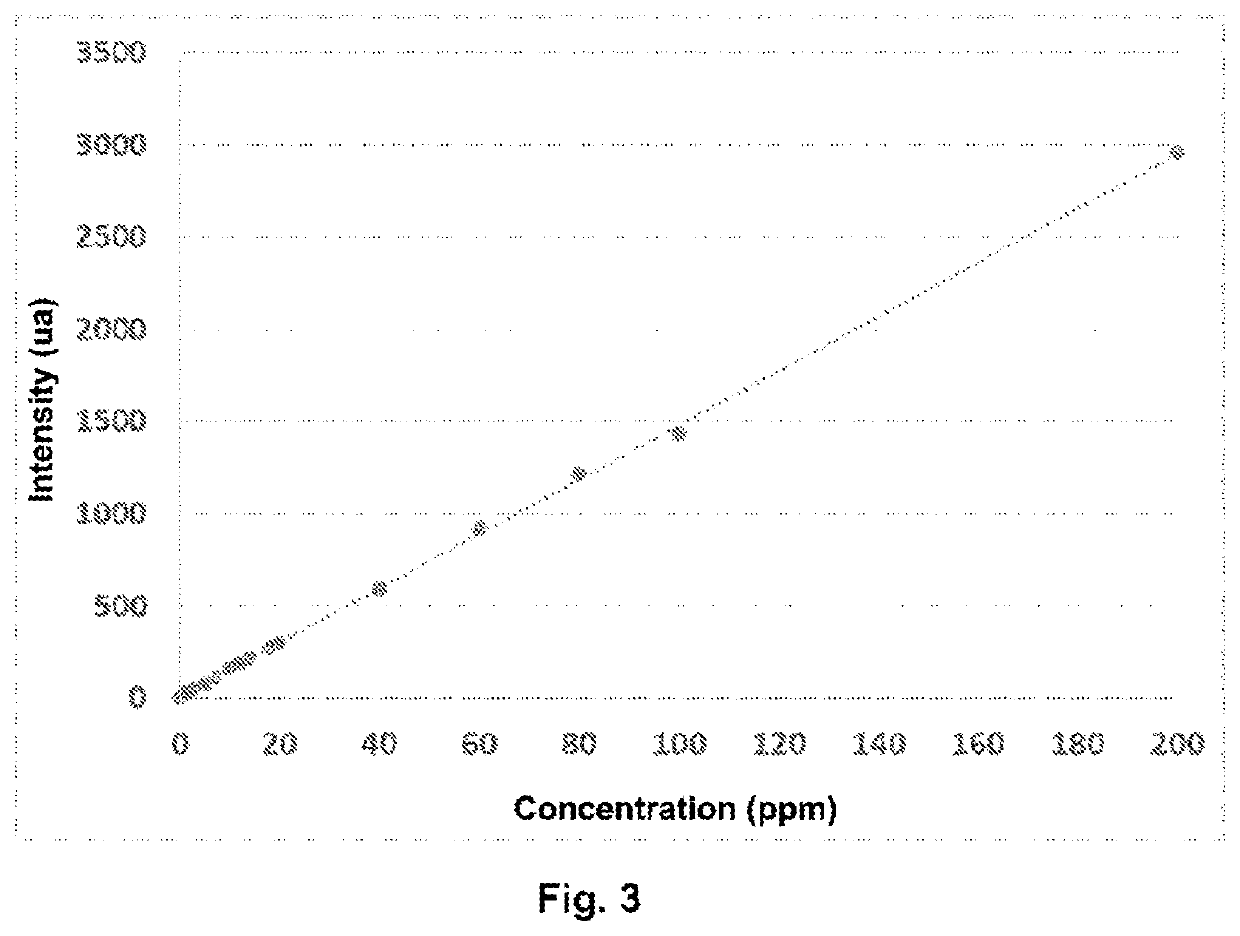Method for assaying cationic polymers by time-resolved photoluminescence
a cationic polymer and photoluminescence technology, applied in the direction of fluorescence/phosphorescence, testing water, instruments, etc., can solve the problems of changing the application performance, environmental problems and additional production costs, and restrictive methods, so as to reduce background noise.
- Summary
- Abstract
- Description
- Claims
- Application Information
AI Technical Summary
Benefits of technology
Problems solved by technology
Method used
Image
Examples
example 1
of the Residual Concentration of a Coagulating Cationic Polymer in Industrial Effluent Water
[0081]This example relates to the assaying of the residual concentration of a cationic coagulant of type poly(DADMAC), present in an industrial effluent water (conductivity of 385 μS.cm−1 at 20° C.).
[0082]a) Preparation of Control Solutions
[0083]Solutions of known concentrations were prepared of poly(DADMAC) (trade name: Floquat FL4440-SNF) by successive dilution of a stock solution of polymer with water having the same chemical salt composition as the industrial water (Table 1).
[0084]
TABLE 1Concentration of control solutions of poly(DADMAC)Concentration (ppm, byweight relative to theReferenceChemical compositionweight of the solution)A0—0A1poly(DADMAC)0.4A2poly(DADMAC)0.8A3poly(DADMAC)1A4poly(DADMAC)1.5A5poly(DADMAC)2A6poly(DADMAC)4A7poly(DADMAC)6A8poly(DADMAC)8A9poly(DADMAC)10 A10poly(DADMAC)15 A11poly(DADMAC)20
[0085]The characteristics of the dilution water are:
[0086]Iron concentration: 10...
example 2
Assay of a Cationic Polyamine in Industrial Aggregate Wash Water
[0114]This example relates to the assaying of the residual concentration of a cationic coagulant of type poly(quaternary amine) present in industrial water from aggregate washing.
[0115]a) Preparation of Control Solutions
[0116]The following solutions of different concentrations are prepared by successive dilution of a stock solution of poly(cationic amine) (trade name: Floquat FL2250-SNF) with water having the same salt and conductivity characteristics as the produced water.
[0117]
TABLE 2Composition of the control solutions of poly(cationic amine)Concentration (ppm, byweight relative to the weightReferenceChemical compositionof the solution)B0—0B1poly(cationic amine)0.5B2poly(cationic amine)1B3poly(cationic amine)1.5B4poly(cationic amine)2B5poly(cationic amine)5B6poly(cationic amine)10
[0118]The characteristics of the dilution water are:
[0119]Conductivity: 504 μS.cm−1
[0120]Iron concentration: 185 μg / l
[0121]b) Complexation...
example 3
Assay of a Flocculating Copolymer in Water Resulting from Industrial Sludge Flocculation
[0144]This example relates to the assaying of the residual concentration of a cationic flocculant of type poly(AM-co-ADAME quat) with a very high weight-average molar mass present in industrial water resulting from the flocculation of industrial sludge from a purification plant.
[0145]a) Preparation of Control Solutions
[0146]The following solutions of different concentrations are prepared by successive dilution of a stock solution of poly(AM-co-ADAME quat) (trade name: Flopaam FO 4650 SSH-SNF) with water having the same salt and conductivity characteristics as the produced water.
[0147]
TABLE 3Composition of the control solutions of poly(AM-co-ADAME quat)Concentration (ppm, byweight relative to theReferenceChemical compositionweight of the solution)C0—0C1poly(AM-co-ADAME quat)0.5C2poly(AM-co-ADAME quat)1C3poly(AM-co-ADAME quat)2C4poly(AM-co-ADAME quat)3C5poly(AM-co-ADAME quat)5C6poly(AM-co-ADAME qua...
PUM
| Property | Measurement | Unit |
|---|---|---|
| emission signal wavelength λem | aaaaa | aaaaa |
| emission signal wavelength λem | aaaaa | aaaaa |
| emission signal wavelength λem | aaaaa | aaaaa |
Abstract
Description
Claims
Application Information
 Login to View More
Login to View More - R&D
- Intellectual Property
- Life Sciences
- Materials
- Tech Scout
- Unparalleled Data Quality
- Higher Quality Content
- 60% Fewer Hallucinations
Browse by: Latest US Patents, China's latest patents, Technical Efficacy Thesaurus, Application Domain, Technology Topic, Popular Technical Reports.
© 2025 PatSnap. All rights reserved.Legal|Privacy policy|Modern Slavery Act Transparency Statement|Sitemap|About US| Contact US: help@patsnap.com


